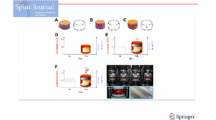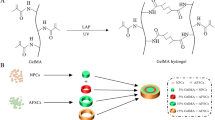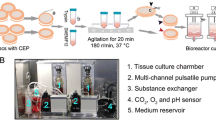Abstract
Purpose
The aim of this study was to compare two approaches for the delivery of biomaterials to partially nucleotomised intervertebral discs in whole organ culture under loading. Such models can help to bridge the gap between in vitro and in vivo studies by assessing (1) suitability of biomaterial delivery and defect closure methods, (2) effect of mechanical loading and (3) tissue response.
Methods
Mechanical performance of bovine discs filled with a hyaluronan-based thermoreversible hydrogel delivered through the annulus fibrosus (AF) or the bony endplate (EP) was evaluated under cyclic axial loading in a bioreactor. The loading protocol was optimised to achieve physiological disc height changes in nucleotomised discs. A loading regime of 0.06 ± 0.02 MPa, 0.1 Hz, 6 h daily was applied on the nucleotomised discs. Disc height and stiffness were tracked for 5 days, followed by histological analyses.
Results
Creation of a defect is less demanding for AF approach, while sealing is superior with the EP approach. Dynamic compressive stiffness is reduced following nucleotomy, with no significant difference between the two approaches. Disc height loss was higher, disc height recovery was lower and region around the defect with reduced cell viability was smaller for AF-approached than EP-approached discs.
Conclusions
Two alternative methods for biomaterial testing in whole organ culture under loading were developed. Such models bring insights on the ability of the biomaterial to restore the mechanical behaviour of the discs. From a clinical perspective, the cavity models can simulate treatment of nucleotomy after disc herniation in young patients, whereby the remaining nucleus pulposus is still functional and therefore at high risk of re-herniation, though the defect may differ from the clinical situation.







Similar content being viewed by others
References
Guterl CC, See EY, Blanquer SB, Pandit A, Ferguson SJ, Benneker LM, Grijpma DW, Sakai D, Eglin D, Alini M, Iatridis JC, Grad S (2013) Challenges and strategies in the repair of ruptured annulus fibrosus. Eur Cell Mater 25:1–21
Grad S, Alini M, Eglin D, Sakai D, Mochida J, Mahor S, Collin E, Dash B, Pandit A (2010) Cells and biomaterials for intervertebral disc regeneration. Morgan and Claypool, San Rafael
Chen WH, Liu HY, Lo WC, Wu SC, Chi CH, Chang HY, Hsiao SH, Wu CH, Chiu WT, Chen BJ, Deng WP (2009) Intervertebral disc regeneration in an ex vivo culture system using mesenchymal stem cells and platelet-rich plasma. Biomaterials 30:5523–5533. doi:10.1016/j.biomaterials.2009.07.019
Haschtmann D, Stoyanov JV, Ettinger L, Nolte LP, Ferguson SJ (2006) Establishment of a novel intervertebral disc/endplate culture model: analysis of an ex vivo in vitro whole-organ rabbit culture system. Spine (Phila Pa 1976) 31:2918–2925. doi:10.1097/01.brs.0000247954.69438.ae
Illien-Junger S, Gantenbein-Ritter B, Grad S, Lezuo P, Ferguson SJ, Alini M, Ito K (2010) The combined effects of limited nutrition and high-frequency loading on intervertebral discs with endplates. Spine (Phila Pa 1976) 35:1744–1752. doi:10.1097/BRS.0b013e3181c48019
Korecki CL, Costi JJ, Iatridis JC (2008) Needle puncture injury affects intervertebral disc mechanics and biology in an organ culture model. Spine (Phila Pa 1976) 33:235–241. doi:10.1097/BRS.0b013e3181624504
Vadala G, Russo F, Pattappa G, Schiuma D, Peroglio M, Benneker LM, Grad S, Alini M, Denaro V (2013) The transpedicular approach as an alternative route for intervertebral disc regeneration. Spine (Phila Pa 1976) 38:E319–E324. doi:10.1097/BRS.0b013e318285bc4a
Botsford DJ, Esses SI, Ogilvie-Harris DJ (1994) In vivo diurnal variation in intervertebral disc volume and morphology. Spine (Phila Pa 1976) 19:935–940
Peroglio M, Eglin D, Benneker LM, Alini M, Grad S (2013) Thermoreversible hyaluronan-based hydrogel supports in vitro and ex vivo disc-like differentiation of human mesenchymal stem cells. Spine J 13:1627–1639. doi:10.1016/j.spinee.2013.05.029
Alini M, Eisenstein SM, Ito K, Little C, Kettler AA, Masuda K, Melrose J, Ralphs J, Stokes I, Wilke HJ (2008) Are animal models useful for studying human disc disorders/degeneration? Eur Spine J 17:2–19. doi:10.1007/s00586-007-0414-y
Li Z, Kaplan KM, Wertzel A, Peroglio M, Amit B, Alini M, Grad S, Yayon A (2014) Biomimetic fibrin-hyaluronan hydrogels for nucleus pulposus regeneration. Regen Med 9:309–326. doi:10.2217/rme.14.5
D’Este M, Alini M, Eglin D (2012) Single step synthesis and characterization of thermo responsive hyaluronan hydrogels. Carbohydr Polym 90:1378–1385. doi:10.1016/j.carbpol.2012.07.007
Junger S, Gantenbein-Ritter B, Lezuo P, Alini M, Ferguson SJ, Ito K (2009) Effect of limited nutrition on in situ intervertebral disc cells under simulated-physiological loading. Spine (Phila Pa 1976) 34:1264–1271. doi:10.1097/BRS.0b013e3181a0193d
Stoddart MJ, Furlong PI, Simpson A, Davies CM, Richards RG (2006) A comparison of non-radioactive methods for assessing viability in ex vivo cultured cancellous bone: technical note. Eur Cell Mater 12:16–25 (discussion 16-25)
Buser Z, Kuelling F, Liu J, Liebenberg E, Thorne KJ, Coughlin D, Lotz JC (2011) Biological and biomechanical effects of fibrin injection into porcine intervertebral discs. Spine (Phila Pa 1976) 36:E1201–E1209. doi:10.1097/BRS.0b013e31820566b2
Allen MJ, Schoonmaker JE, Bauer TW, Williams PF, Higham PA, Yuan HA (2004) Preclinical evaluation of a poly (vinyl alcohol) hydrogel implant as a replacement for the nucleus pulposus. Spine (Phila Pa 1976) 29:515–523
Iatridis JC, Nicoll SB, Michalek AJ, Walter BA, Gupta MS (2013) Role of biomechanics in intervertebral disc degeneration and regenerative therapies: what needs repairing in the disc and what are promising biomaterials for its repair? Spine J 13:243–262. doi:10.1016/j.spinee.2012.12.002
Joshi A, Fussell G, Thomas J, Hsuan A, Lowman A, Karduna A, Vresilovic E, Marcolongo M (2006) Functional compressive mechanics of a PVA/PVP nucleus pulposus replacement. Biomaterials 27:176–184. doi:10.1016/j.biomaterials.2005.06.003
Vadala G, De Strobel F, Bernardini M, Denaro L, D’Avella D, Denaro V (2013) The transpedicular approach for the study of intervertebral disc regeneration strategies: in vivo characterization. Eur Spine J 22(Suppl 6):S972–S978. doi:10.1007/s00586-013-3007-y
Johannessen W, Cloyd JM, O’Connell GD, Vresilovic EJ, Elliott DM (2006) Trans-endplate nucleotomy increases deformation and creep response in axial loading. Ann Biomed Eng 34:687–696. doi:10.1007/s10439-005-9070-8
Park C, Kim YJ, Lee CS, An K, Shin HJ, Lee CH, Kim CH, Shin JW (2005) An in vitro animal study of the biomechanical responses of anulus fibrosus with aging. Spine (Phila Pa 1976) 30:E259–E265
Nachemson A (1975) Towards a better understanding of low-back pain: a review of the mechanics of the lumbar disc. Rheumatol Rehabil 14(3):129–143
Wilke HJ, Neef P, Caimi M, Hoogland T, Claes LE (1999) New in vivo measurements of pressures in the intervertebral disc in daily life. Spine 24(8):755–762
Reitmaier S, Schmidt H, Ihler R, Kocak T, Graf N, Ignatius A, Wilke HJ (2013) Preliminary investigations on intradiscal pressures during daily activities: an in vivo study using the merino sheep. PLoS One 8(7):e69610. doi:10.1371/journal.pone.0069610
Guehring T, Unglaub F, Lorenz H, Omlor G, Wilke HJ, Kroeber MW (2006) Intradiscal pressure measurements in normal discs, compressed discs and compressed discs treated with axiao posterior disc disctration: an experimental study on the rabbit lumbar spine model. Eur Spine J 15(5):597–604
Korecki CL, MacLean JJ, Iatridis JC (2007) Characterization of an in vitro intervertebral disc organ culture system. Eur Spine J 16(7):1029–1037
Korecki CL, MacLean JJ, Iatridis JC (2008) Dynamic compression effects on intervertebral disc mechanics and biology. Spine (Phila Pa 1976) 33(13):1403–1409
Wang DL, Jiang SD, Dai LY (2007) Biologic response of the intervertebral disc to static and dynamic compression in vitro. Spine (Phila Pa 1976) 32(23):2521–2528
Ramakrishnan PS, Hong J, Martin JA, Kurriger GL, Buckwalter JA, Lim TH (2010) Biomechanical disc culture system: feasibility study using rat intervertebral discs. J Eng Med 225:611–620
Paul CPL, Zuiderbaan HA, Zandieh Doulabi B, van der Veen AJ, van de Ven PM, Smit TH, Helder MN, van Royen BJ, Mullender MG (2012) Simulated-physiological loading conditions preserve biological and mechanical properties of caprine lumbar intervertebral discs in ex vivo culture. PLoS One 7(3):e33147. doi:10.1371/journal.pone.0033147
Chan SC, Ferguson SJ, Wuertz K, Gantenbein-Ritter B (2011) Biological response of the intervertebral disc to repetitive short-term cyclic torsion. Spine (Phila Pa 1976) 36(24):2021–2030
Gantenbein B, Illien-Jünger S, Chan SC, Walser J, Haglund L, Ferguson SJ, Iatridis JC, Grad S (2015) Organ culture bioreactors—platforms to study human intervertebral disc degeneration and regenerative therapy. Curr Stem Cell Res Ther 10(4):339–352
Gawri R, Mwale F, Ouellet J, Roughley PJ, Steffen T, Antoniou J, Haglund L (2011) Development of an organ culture system for long-term survival of the intact human intervertebral disc. Spine (Phila Pa 1976) 36:1835–1842. doi:10.1097/BRS.0b013e3181f81314
Ariga K, Yonenobu K, Nakase T, Hosono N, Okuda S, Meng W, Tamura Y, Yoshikawa H (2003) Mechanical stress-induced apoptosis of endplate chondrocytes in organ-cultured mouse intervertebral discs: an ex vivo study. Spine (Phila Pa 1976) 28:1528–1533
Hunter CJ, Matyas JR, Duncan NA (2004) Cytomorphology of notochordal and chondrocytic cells from the nucleus pulposus: a species comparison. J Anat 205:357–362
Pattappa G, Li Z, Peroglio M, Wismer N, Alini M, Grad S (2012) Diversity of intervertebral disc cells: phenotype and function. J Anat 221:480–496
Chan SC, Burki A, Bonel HM, Benneker LM, Gantenbein-Ritter B (2013) Papain-induced in vitro disc degeneration model for the study of injectable nucleus pulposus therapy. Spine J 13:273–283. doi:10.1016/j.spinee.2012.12.007
Jim B, Steffen T, Moir J, Roughley P, Haglund L (2011) Development of an intact intervertebral disc organ culture system in which degeneration can be induced as a prelude to studying repair potential. Eur Spine J 20:1244–1254. doi:10.1007/s00586-011-1721-x
Acknowledgments
This study was supported by the European Commission under the FP7-NMP project NPmimetic (246351), AO Spine and North American Spine Society research grant. The authors gratefully acknowledge Stephan Zeiter for advice on suture techniques and Lorin Benneker for endplate approach development, Matteo D’Este and David Eglin for providing the hyaluronan hydrogel, Nora Goudsouzian and Mauro Bluvol for histological processing and Stephen Ferguson for valuable discussions.
Author information
Authors and Affiliations
Corresponding author
Ethics declarations
Conflict of interest
The authors have nothing to disclose concerning the content of this manuscript.
Rights and permissions
About this article
Cite this article
Li, Z., Lezuo, P., Pattappa, G. et al. Development of an ex vivo cavity model to study repair strategies in loaded intervertebral discs. Eur Spine J 25, 2898–2908 (2016). https://doi.org/10.1007/s00586-016-4542-0
Received:
Revised:
Accepted:
Published:
Issue Date:
DOI: https://doi.org/10.1007/s00586-016-4542-0




